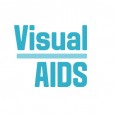 |
| ALTERNATE ENDINGS post-screening discussion at the SVA Theatre featuring Amy Taubin, Tom Kalin, Lyle Ashton Harris, Derek Jackson and Wanda Hernandez-Parks. Photo by Ted Kerr. |
We would like to thank everyone who joined us at SVA Theatre on World AIDS Day December 1, 2014 for the NYC premiere of ALTERNATE ENDINGS, on the 25th Anniversary of Day With(out) Art.
To honor the 25th year of Day With(out) Art, Visual AIDS commissioned seven artists/collectives--Rhys Ernst, Glen Fogel, Lyle Ashton Harris, Hi Tiger, Tom Kalin, My Barbarian, and Julie Tolentino/Abigail Severance--to create provocative work about the ongoing HIV/AIDS pandemic, focusing on the issues of today. The program, titled ALTERNATE ENDINGS, highlights the diverse voices of seven artists that use video to bring together charged moments and memories from their personal perspective amidst the public history of HIV/AIDS. All seven videos are now available for online viewing in the ALTERNATE ENDINGS album on Visual AIDS’ Vimeo account.
A packed house of over 150 people watched the videos premiere on the big screen of the SVA Theatre. A post-screening discussion moderated by SVA professor Amy Taubin featured artists Tom Kalin, Lyle Ashton Harris, and Derek Jackson as well as activist Wanda Hernandez-Parks (VOCAL-NY), providing insights into the process and perspective behind the videos. Clips from the thought-provoking and generative discussion are embedded below, and also viewable on Visual AIDS’ Vimeo account.
The lively premiere event was documented by Jon Nalley (Social + Diarist); his photos are in a Facebook album.
Excerpt: “The starting point for me was the back of books, I encountered the little stamp sheets, where you check out a book. And it occurred to me these little pieces of paper in the back of these books had experienced the AIDS crisis just as long as I had. They were from 1986 and 1987 and were checked out and stamped. The thought that they were skin or that they had been touched all those times, all those years was really evocative to realize the sense that AIDS was everywhere, in all the common objects I touched. AIDS has been the dominant thread of my life for the last 27 or more years. AIDS is everywhere. AIDS is a part of everything.”
Excerpt: “’The Village’ is a song by New Order... I grew up on the border of Mexico and Texas, listening to that kind of music. The connection was that we related to the outsider status, the humor, the irony of the music... Later as an adult I returned to some of these songs and found, instead of imitating their voice, I could sing them in my own. And that’s when I knew I had essentially found my voice.”
Excerpt: “It was a way of just documenting my life, friends. Also, it captures my close relationships and associations with a lot of men and women who have left. People who were very much in the forefront in terms of AIDS activism, like Marlon Riggs, but often you never see the interiority. If you think about a book like Nan Goldin’s ’The Ballad of Sexual Dependency’, often, as far as black culture discourse, you never see that personal aesthetic. I wanted to create a narrative that actually began to tease at that. In addition to that, to talk about the faultline that existed among multiple communities, whether that was the queer community, black community, artistic community, etc. This archive in a way begins to tease at those relationships.”
Excerpt: “It’s about human rights. It’s about what we all should fight for because at the end of the day we are not statistics, we are actually somebody’s son, somebody’s daughter, somebody’s nephew, somebody’s parent... for me it’s a personal vendetta to go ahead and end AIDS by 2020, which can be done.”
Excerpt: “One of the main strategies of ACT-UP and activist graphics was humor. I think it’s much forgotten about ACT-UP that it was funny, really funny. And most of us used humor as a conduit to express rage... The idea that the only emotion that AIDS provokes is sadness or grief is wrong. HIV and AIDS, there is a huge spectrum. HIV and AIDS can have a spectrum for me of boredom now, of familiarity, of casualness, of ordinariness. It’s part of my day to day life... Anger is only part of the equation. I think anger was an incredible wedge of momentum and collective movement that really changed things.”
Excerpt: “I felt like with the ’queer art mafia’, this cult of who is the cutest white boy artist at the moment, and I was never that. Then with the blacks, feeling too much of a fag to be hard or hip hop. It was very lonely. In terms of risk and HIV, that’s a risky place to be in. So in terms of art and that question ’can art save lives?’ that is a place where I feel safe, where I can carve out what it means to be all of this, all the time, not one or the other.”
Videography by Bart Mastronardi. Editing by Azmi Mert Erdem.







Comments
Comments